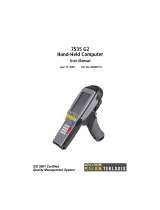
"
NOTICE This publication contains information proprietary to Intermec Technologies Corpo-
ration. It is being supplied to you with the express understanding that the informa-
tion contained herein is for the benefit of the contracting party only, and may not
be copied, distributed, or displayed to third parties without the express written
consent of Intermec Technologies Corporation, and shall be returned to Intermec
Technologies Corporation upon written request. If a purchase, license, or nondisclo-
sure agreement has been executed, the terms of that agreement shall govern this
document.
This publication is furnished for information only, and the information in it is
subject to change without notice. Although every effort has been made to provide
complete and accurate information, Intermec Technologies Corporation assumes no
responsibility or liability for any errors or inaccuracies that may appear in this
document.
Disclaimer of Warranties. The sample source code included in this document is
presented for reference only. The code does not necessarily represent complete,
tested programs. The code is provided “AS IS WITH ALL FAULTS.” ALL
WARRANTIES ARE EXPRESSLY DISCLAIMED, INCLUDING THE
IMPLIED WARRANTIES OF MERCHANTABILITY AND FITNESS FOR A
PARTICULAR PURPOSE.
We welcome your comments concerning this publication. Although every effort has
been made to keep it free of errors, some may occur. When reporting a specific
problem, please describe it briefly and include the book title and part number, as
well as the paragraph or figure number and the page number.
Send your comments to:
Intermec Technologies Corporation
Publications Department
550 Second Street SE
Cedar Rapids, IA 52401
INTERMEC, NORAND, PEN*KEY, PEN*VIEW, ROUTE-COMMANDER, and
BEVERAGE ROUTEBOOK are registered trademarks and NOR*WARE and
RAPIDREP are trademarks of Intermec Technologies Corporation.
Ó 1998 Intermec Technologies Corporation. All rights reserved.
Acknowledgments
Alexander is a registered trademark of Alexander Manufacturing Co.
Ethernet is a trademark of Xerox Corporation.
Microclean II is a registered trademark of Foresight International.
Microsoft, MS, and MS-DOS, and Windows, are registered trademarks and Visual
Basic for Windows, and Windows for Pen are trademarks of Microsoft Corporation.
SanDisk is a trademark of SanDisk Corporation




















